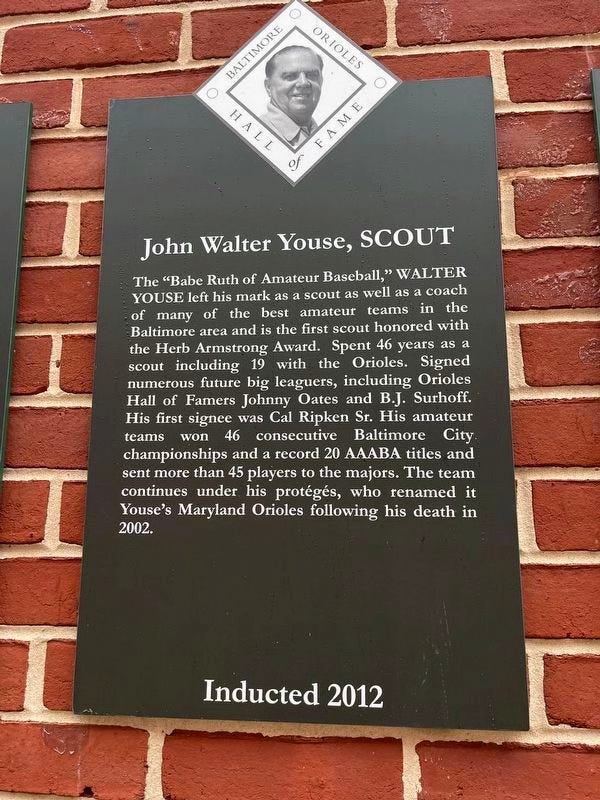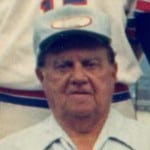The Bird Tapes Interview: Walter Youse
In a guest post, longtime Baltimore baseball writer Jim Henneman profiles Youse, the legendary amateur coach and scout, whom I was fortunate to interview for my book on Orioles history in 1999.
Walter Youse belongs in the first rank of Baltimore baseball royalty. The championship-caliber amateur teams he coached for decades featured nearly four dozen future major leaguers and even future Hall of Famers Al Kaline and Reggie Jackson. Youse also worked as a professional scout for nearly a half-century, signing hundreds of players.
I interviewed him for my book on Orioles history because his scouting career began when Paul Richards hired him in the 1950s. The first prospect he scouted was a 21-year-old catcher from Aberdeen named Cal Ripken. Shortly thereafter, he signed Steve Barber, a pitcher who’d dropped out of the University of Maryland and later became the Orioles’ first 20-game winner.
Youse scouted for the Orioles through a golden age, into the early 1970s, when he followed Harry Dalton to the California Angels. He later followed Dalton again to the Milwaukee Brewers. (Dalton had been the Orioles’ GM and later was GM of both the Angels and Brewers.) But he never left Baltimore and continued to coach his amateur teams. He was inducted into the Orioles’ Hall of Fame in 2012.
Although I interviewed Youse for my book a quarter-century ago, I didn’t know him nearly as well as Jim Henneman, my Baltimore sportswriting colleague for many years. Henneman, who is, cough, a few years old than me, actually played for Youse in the 1950s and they maintained a close relationship for decades.
I asked Henneman if he would write about his former coach as an introduction to my interview with Youse, which is posted below and available to paid Bird Tapes subscribers. Henneman graciously agreed to do it. His piece on Youse is also below and available to all subscribers.
The Orioles named the press box at Camden Yards after Henneman earlier this year, a high and deserved honor. I’m delighted to be able to offer his thoughts on Youse to the Bird Tapes community.
When One Baseball Lifer Signed Another
By Jim Henneman
Walter Youse was hardly the amateur baseball guru he would become in Baltimore when he got a gig as a part-time scout for the Orioles in 1957. But he was on his way and it wouldn’t take long.
He had already produced a string of state American Legion championship teams, including one that went to the national finals and included Al Kaline, a future Hall of Famer who would go on to lead the American League in hitting at age 20. The Orioles never had a chance to sign Kaline, who graduated from Southern High School in 1953 and signed with the Tigers one year before the St. Louis Browns moved to Baltimore.
But three years later, another outfielder, Barry Shetrone, was following a similar route and his eventual signing with the Orioles resulted in Youse getting the job -- a perceived thank you for his help with negotiations. Youse would go on to sign hundreds, maybe even thousands, of players for the Orioles, Angels and Brewers, the three teams he worked for in his more than 60 years in professional baseball.
I played on Youse’s first high school team at Calvert Hall and also spent one year with his Westport team, where I also filled in as his temporary coaching replacement when he had to surrender that job because of his association with professional baseball, a no-no under American Legion guidelines.
We stayed close throughout our careers and I was playing at what is now Loyola University when Walter signed his first player to a minor league contract. It didn’t have any impact at the time, but I still remember the phone conversation like it was yesterday.
“He’s a little older, a 21-year-old catcher, and I don’t know if he can make it to the big leagues, but they (the Orioles) need a catcher and I think he could be a good organization man down the road,” said Youse, enthused about his first signing.
Little did he, I, the Orioles or the rest of the baseball world have any idea what would come of that signing. In those days, the 21-year-old catcher was known simply as Cal Ripken because there wouldn’t be a Junior for a few more years. The rest, as we know, is history.
To this day, though it couldn’t have resonated with either of us at the time, I think Rip had more of Youse’s traits than anyone who may have played or coached for him. Most O’s fans know, or have heard of, Senior’s legendary no-nonsense approach. Practice sessions for pickoffs, relays and cutoffs didn’t have a time limit, and they were repeated if necessary until done right. Think: “practice doesn’t make perfect, PERFECT practice makes perfect.”
Unless you played or coached for him, you wouldn’t know (or perhaps understand) some of Walter’s rules. For openers, if you were going to earn a uniform, you had to learn how to wear it. And that meant wearing it a certain way, with the pant legs folded precisely between the knee and calf. Just to make sure everybody got the same message, veteran players were assigned to teach the “rookies” how to dress. I often wonder how that would go over today, with ankle-length uniforms the accepted style. Somehow, I think Walter would come up with a compromise that would make his players think it was their idea.
Another rule: if vacations were part of your family’s summer ritual, a decision would have to be made, and it would be either/or, no compromise, until the season was over. Also: the practices and preliminary games for tournaments (which his teams routinely won) were just as important as the tournaments. Another: if you were a pitcher, don’t even think about going to the swimming pool. (That rule that might not pass muster today, but I’m still not sure Walter would give in.)
Like Youse, Rip was more “old school” in both dress and training codes, and there were times he’d take chores on himself – like driving the bus or manicuring the infield if he felt it necessary. He was, as Youse said all those years ago, a good organization man. His reward was managing Cal Jr. and Bill in the major leagues, on the Orioles, even though his dream job couldn’t have come at a worse time, with the organization at an all-time low.
If I had two words to describe these two baseball lifers, the first could be commitment, the second stubborn. And believe me a stubborn commitment is tough to beat.
I always felt it was a mistake on both sides when Youse left the Orioles shortly after Harry Dalton joined the Angels, and then later moved on to Milwaukee with the “Dalton Gang.” It was the beginning of drastic changes for the Orioles’ organization – and the same could be said about the end of Cal Sr’s career.
I’ve often thought about Walter’s prediction when he signed Rip, but we never talked about it at length after he left. As for Cal Sr., I never told him the story, but I know he would’ve liked the comparison.
Too bad they couldn’t have spent their careers together in the organization where they started.
Keep reading with a 7-day free trial
Subscribe to The Bird Tapes to keep reading this post and get 7 days of free access to the full post archives.






